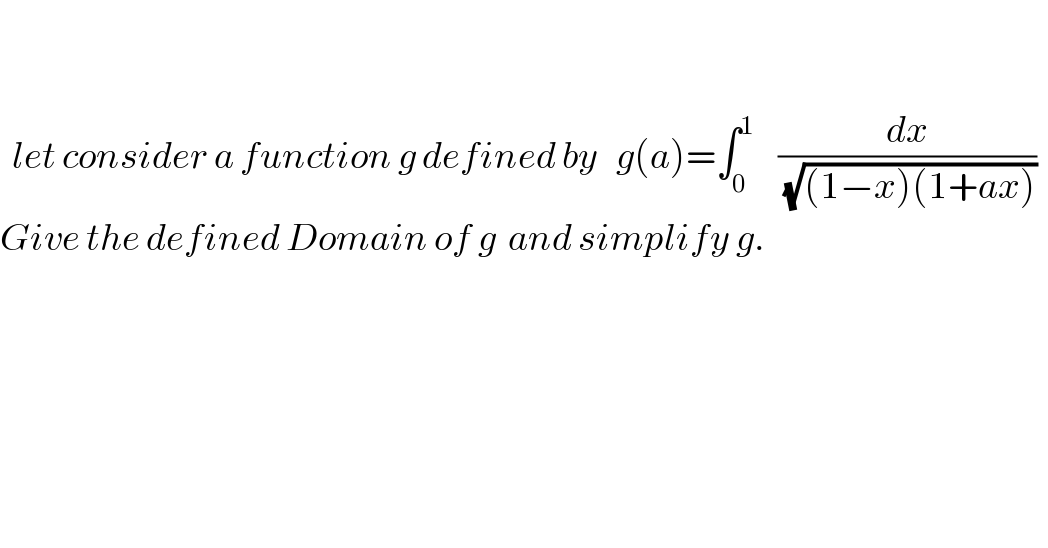
Question and Answers Forum
Question Number 67465 by ~ À ® @ 237 ~ last updated on 27/Aug/19

Commented by ~ À ® @ 237 ~ last updated on 28/Aug/19
![D_g ={ a∈R/ g(a)∈R} we know that ∫_0 ^1 (dx/((√(1−u^2 )) ))= (π/2) ( so it converges). Then lim_(x→1) (((√(1−u^2 )) )/(√((1−u)(1+au)))) =(√(2/(1+a))) by convergence theorem g(a) exist if (√((2/(1+a)) )) ∈ R ⇔ a>−1 So D_g = ]−1;+∞[ If a=0 g(0)=∫_0 ^1 (( dx)/((√(1−x)) ))=[−2(√(1−x)) ]_0 ^1 =2 Now if a≠0 and a∈]−1;+∞[ g(a)=∫_0 ^1 (du/(√(u(1+a−au)))) ( with u=1−x ) = (1/(√(1+a))) ∫_0 ^1 u^((−1)/2) (1−((au)/(1+a)))^((−1)/2) du=(1/(√(1+a))) ∫_0 ^1 u^((1/2)−1) (1−u)^((3/2)−(1/2)−1) (1−(a/(1+a))u)^((−1)/2) du = ((Γ((3/2)))/(Γ((1/2))Γ(1)(√(1+a)) )) . _2 F_1 ((1/2),(1/2),(3/2), (a/(1+a))) because ∣(a/(1+a))∣<1 using the formula _2 F_1 ((1/2),(1/2),(3/2),z^2 )=((arcsinz)/z) if a∈]−1;0[ , (a/(1+a))<0 let take z=i(√(∣(a/(1+a))∣)) g(a)=(1/(2(√(1+a)) )) . (1/(i(√(∣(a/(1+a))∣)) )) arcsin(i(√(∣(a/(1+a))∣)) )=_ ((arcsin(i(√((∣a∣)/(1+a))) ))/(2i(√(∣a∣)) )) =((argsh((√(((∣a∣)/(1+a)) )) ))/(2(√(∣a∣)) )) because sin(x)=((e^(ix) −e^(−ix) )/(2i))= ((sh(ix))/i) ⇒ sin( arcsin(ix))=((sh(iarcsin(ix)))/i) ⇒ iargshx=arcsin(ix) if a>0 then (a/(1+a))>0 we take z=(√(a/(1+a))) g(a)=((arcsin((√((a/(1+a)) )) ))/(2(√a)))](Q67491.png)
Commented by prof Abdo imad last updated on 28/Aug/19
![at V(1) g(a) ∼ ∫_0 ^1 (dx/(√((1−x)(1+a)))) g(a) exist ⇔ 1+a>0 ⇒a>−1 ⇒ D_g =]−1,+∞[ .](Q67494.png)
Commented by prof Abdo imad last updated on 28/Aug/19

Commented by mathmax by abdo last updated on 28/Aug/19
![case 2 if a>0 ⇒Δ^′ >0 ⇒t_1 =((√(a^2 +a))/a) and t_2 =−((√(a^2 +a))/a) g(a) = 2∫_0 ^1 (dt/(√(−a(t−t_1 )(t−t_2 )))) =(2/(√a)) ∫_0 ^1 (dt/(√((t_1 −t)(t−t_2 )))) we use the changement (√(t_1 −t))=u ⇒t_1 −t =u^2 ⇒t =t_1 −u^2 g(a) =(2/(√a)) ∫_(√t_1 ) ^(√(t_1 −1)) (((−2u)du)/(u(√(t_1 −u^2 −t_2 )))) =((−4)/(√a)) ∫_(√t_1 ) ^(√(t_1 −1)) (du/(√(t_1 −t_2 −u^2 ))) =((−4)/(√a)) ∫_(√t_1 ) ^(√(t_1 −1)) (du/(√(((√(t_1 −t_2 )))^2 −u^2 ))) =_(u=(√(t_1 −t_2 ))z) ((−4)/(√a)) ∫_((√t_1 )/(√(t_1 −t_2 ))) ^((√(t_1 −1))/(√(t_1 −t_2 ))) (((√(t_1 −t_2 )) dz)/((√(t_1 −t_2 ))((√(1−z^2 ))))) =((−4)/(√a))[arcsin(z)]_(√(t_1 /(t_1 −t_2 ))) ^(√((t_1 −1)/(t_1 −t_2 ))) =((−4)/(√a)){ arcsin((√((t_1 −1)/(t_1 −t_2 ))))−arcsin((√(t_1 /(t_1 −t_2 ))))}](Q67550.png)
